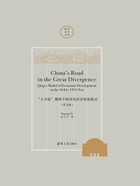
2. Population Expansion in the Early Qing
While the first section presented a historical summary of the internal Chinese discourse on demographic policies during the Early Qing era, the following section empirically establishes the size of the Chinese population at the same time. It is very difficult, however, to estimate the population of ancient China since the census standards varied greatly and were primarily used for estimating taxes. However, with the tedious and impressive work of many scholars, the population estimates of Qing China have become increasingly accurate. Among them, Cao Shuji’s data has the biggest influence.(6)
Table 1.1 Population in the Qing Dynasty

(Continued)

Source: Cao Shuji, Population history, vol.4, pp.451-452; vol.5, pp.703-704. Due to the limit, Cao’s book does not offer the 1644 population data for Liaoning, Jilin, Heilongjiang,Qinghai and Xinjiang provinces.
Below you can find a graph of the absolute size of population and how it changed during the Qing Dynasty.

Figure 1.1 Population in the Qing Dynasty
Regarding Figure 1.1, we can see that there was a sharp population increase before 1850, during a period of almost 100 years of peace. The population in-creased from 150 million in 1644 to 436 million in 1851, more than doubling(almost tripling) in over 200 years.(7)
The population expansion resulted in a series of socio-economic problems.It is common knowledge that in the last decades of the 19th century, the living standards of ordinary people dropped to a very critical level and even caused the concerns of the court. Even more than 100 years earlier, it already had attracted the attention of the Emperor:
The Kangxi Emperor (in power from 1661 to 1722) had a clear understanding of the pressures associated with the population size. In 1699 when he travelled to the Yangtze area, the richest area of China, he said that “I have always applied an exemption from the land tax and delivered relief as disasters happened in Jiangsu and Zhejiang provinces. However, the living standards of the people are not as good as before.”(8) In 1709, he said that “We have had a long peaceful time and the population has increased very quickly. I have always been worried about the situation where food was not enough for the people, even during the harvest season and year.”(9) “We have united our country for more than 60 years without any war, and the population has increased very quickly, but the amount of arable land has not increased at the same speed. The level of wealth that belonged to one person before should now be divided into several parts;how could that be enough in such a critical situation?”(10) In 1710, he also said that“the people were not as wealthy as before because of the long peacetime, and the population increased without the same growth of arable land and food production. Without enough food, how is it possible to become rich?”(11) In 1712, he said that “the price of rice has increased continuously, and many people cannot even find a job.”(12)
The Yongzheng Emperor (in power from 1723 to 1735) continued his father’s policy. In 1723, he said that: “Our country has last for a long prosperity without any wars and the population expands so quickly that the arable land could not feed the people. If it had a bad crop, people would be hard to find food.”(13) In 1729, Yongzheng pointed out that all the uncultivated land should be used to feed the people.(14) This situation continued to last well into the Qianlong era. In 1791, the Emperor expressed his worries to the court officials that the resources available might not be able to support the growing population.(15)